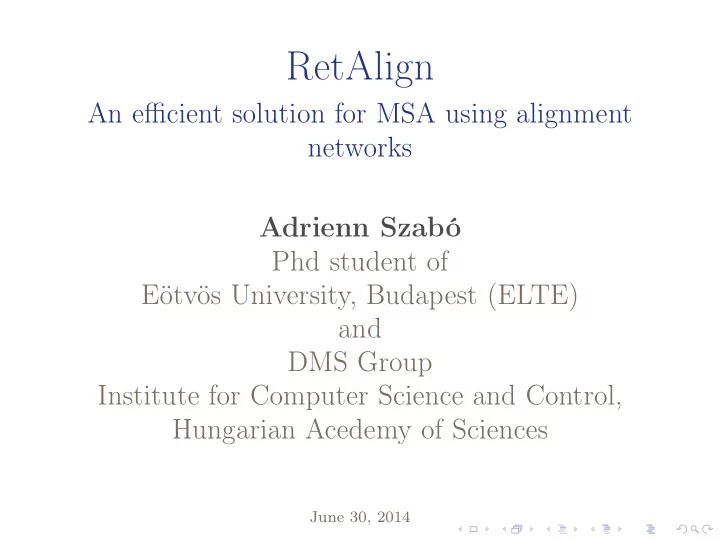

RetAlign An efficient solution for MSA using alignment networks Adrienn Szabó Phd student of Eötvös University, Budapest (ELTE) and DMS Group Institute for Computer Science and Control, Hungarian Acedemy of Sciences June 30, 2014
Table Of Contents 1 Introduction 2 RetAlign algorithm 3 Evaluation, results, future work. . .
About me Education • MSc: Software engineer, Budapest University of Technology and Economics (2008) • PhD: Data mining techniques on biological data (supervisors: András Benczúr, István Miklós ), Eötvös University, Budapest (ongoing)
About me Research interests • Bioinformatics, especially multiple sequence alignment, and problems with a lot of data • Data mining, machine learning, text mining, especially on biological datasets Work • Developer and research assistant at Data Mining and Search Group (head: András Benczúr), MTA SZTAKI (2007 -) • Software engineer intern at Google Zürich (2009)
MSA – Introduction • Multiple sequence alignment (MSA): alignment of three or more biological sequences • Needed for phylogenetic analysis, function prediction of proteins, etc.
Basics – pairwise sequence alignment • The standard edit distance based formulation of sequence alignment leads to O ( L 2 ) • Dynamic programming: Smith-Waterman and Needleman-Wunsch algorithms
Problems with multiple sequence alignment • For straightforward dynamic programming solutions, each additional sequence multiplies the time and memory required • Finding the optimal alignment is NP-complete • Corner-cutting methods shrink the search space, but are still exponential in memory and running time • Heuristics applied: progressive alignment
Progressive alignment • A guide tree is used, and pairwise alignments at each inner node • Polynommial running time • Once a gap has been inserted it can not be removed
RetAlign - main idea • Store a set of optimal and suboptimal alignments at each step of the progressive alignment procedure • Propagate the partial networks at each inner node of a guide tree upwards • Essentially we are extending the Waterman-Byers algorithm to align a network of alignments to another network of alignments
RetAlign - data structure We used a special data structure: x -network: a set of alignment paths that contain the optimal pairwise alignment and all suboptimal paths that have an aligment score above the optimal score minus x Note: this is a DAG
RetAlign - data structure This network shows three different alignments of the sequences ALLGVGQ and AVGQ:
Outline of the RetAlign algorithm 1 Build or load a guide tree for the sequences 2 Bottom-up, for each node v of the tree: • calculate the x v -network of its children’s sub-networks using the generalized Waterman-Byers algorithm 3 Return the best scored alignment from the x -network calculated at the root of the guide tree
Measuring performance • Tested and evaluated on the BAliBASE datasets, that contain more than 6000 sequences • Compared with the most widely used MSA packages: ClustalW, MAFFT and FSA
Accuracy comparison
Current and future work Working on a sequel paper: how to build up an alignment network from multiple separete MSA alignments? • different input parameters for the underlying MSA algorithm • sampling • measure performance
References and sources • Publication: Adrienn Szabó, Ádám Novák, István Miklós, Jotun Hein: Reticular alignment: A progressive corner-cutting method for multiple sequence alignment , BMC Bioinformatics, 2010 • References: • http://en.wikipedia.org/wiki/Sequence_alignment • http://en.wikipedia.org/wiki/Multiple_sequence_alignment • Sources of pictures: • http://upload.wikimedia.org/wikipedia/commons/8/86/ Zinc-finger-seq-alignment2.png • http://cnx.org/content/m15807/latest/
Questions?
Recommend
More recommend